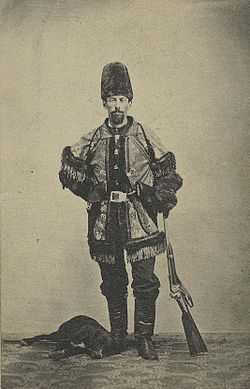Charles R. Jennison
| Charles Rainsford Jennison | |
|---|---|
 Charles R. Jennison, ca. 1855-60 | |
| Nickname | "Doc" |
| Born |
June 6, 1834 Antwerp, New York |
| Died |
June 21, 1884 (aged 50) Leavenworth, Kansas |
| Allegiance | United States of America |
| Years of service | 1861–64 |
| Rank |
|
| Commands held | |
| Battles/wars |
|
Charles R. Jennison also known as "Doc" Jennison (June 6, 1834 – June 21, 1884) was a hero of the anti-slavery faction during the Bleeding Kansas Affair and became even more famous as a Union colonel and as leader of Redlegs during the American Civil War.
Early life and Bleeding Kansas
Charles R. Jennison was born on June 6, 1834 in Antwerp, Jefferson County, New York. His family moved to Wisconsin in 1846 where Jennison studied medicine. Marrying at the age of 20, Dr. Jennison moved to Osawatomie, Kansas in 1858 and to Mound City shortly thereafter.[1] Jennison was considered the most brutal and unscrupulous of the Jayhawkers. Whereas some other prominent leaders of irregulars in the Bleeding Kansas border conflict shared these traits, Jennison was distinguished by his blatant plunder for personal gain.[2] Jennison cooperated with James Montgomery in opposing pro-slavery settlers and irregulars believed to be in league with Border Ruffians. In command of nine men, Jennison "tried" and hanged Russell Hinds near the state line at Mine Creek for the offense of helping to return a fugitive slave to his master in Missouri. Returning a slave was not only legal, but required at the time under the Fugitive Slave Act.[3] Hinds had rejected the standard $25 reward,($515 in 2005 dollars,) but did accept $5 reimbursement for his expenses in transporting the slave, who had agreed to return to his master while awaiting legal emancipation. The acceptance of the reimbursement was enough to convince Jennison to hand down a death sentence.
Civil War
Even before the start of hostilities Jennison became a captain of the Mound City Guards on February 19, 1861.[4] Although not with Senator James H. Lane's Kansas brigade during the Sacking of Osceola, Jennison was associated with it and would soon join the fray after receiving a commission as colonel from Kansas Governor Charles L. Robinson on September 4.[5]
On October 28, 1861, Jennison completed the organization and mustering of his 7th Kansas Cavalry. The regiment would become known as "Jennison's Jayhawkers." It immediately took to the field patrolling the Kansas-Missouri border to prevent the secessionist Missouri State Guard under Sterling Price from crossing. Jennisons was a resolute abolitionist; his sentiments on the matter were the subject of an article in Horace Greeley's New York Daily Tribune. The article reported Jennison as refusing to allow non-abolitionist soldiers to serve under his command, and asserting that "the slaves of rebels can always find a protection in... [his] camp, and [that] they will be defended to the last man and bullet." While the regiment was at Leavenworth, Kansas in April 1862, Jennison, angered over James G. Blunt being named brigadier general in his stead, resigned from the army and turned to banditry as a Redleg.[6][7]
Following the Lawrence Massacre Jennison was once again commissioned a colonel and called into service by Kansas Governor Thomas Carney to raise a regiment that would become the 15th Kansas Cavalry on October 17, 1863.[8]
Colonel Jennison commanded a mixed brigade of Kansas militia and volunteers resisting Price's Raid in October 1864.[9] However, in December he found himself under arrest as the result of plundering while returning through Missouri after the pursuit of Price. Jennison was court-martialled and convicted on June 23, 1865, whereupon he was dishonorably dismissed from the service.[10]
Postwar
Jennison was elected to the Kansas Legislature from Leavenworth County in 1865, re-elected in 1867, and elected to the Kansas State Senate in 1872. He died at Leavenworth, Kansas June 21, 1884.[4]
See also
References
- ↑ Wilkie, Frank B., edited by Banasik, Michael, Missouri in 1861: The Civil War Letters of Frank B. Wilkie, Newspaper Correspondent, Part IV, 2001, page 247, footnote 215
- ↑ Castel, Albert, Civil War in Kansas: Reaping the Whirlwind, (ISBN 0-7006-0872-9), University Press of Kansas, 1997, page 43
- ↑ Cutler, William G., History of the State of Kansas, A. T. Andreas, 1883, "Linn County", Part 4
- ↑ 4.0 4.1 Connelley, William E., A Standard History of Kansas and Kansans, Lewis Publishing Company, 1918, "Charles R. Jennison"
- ↑ "Kansas Jayhawking Raids into Western Missouri in 1861", Missouri Historical Review, Vol. 54 No. 1, October 1959
- ↑ Cutler, William G., History of the State of Kansas, A. T. Andreas, 1883, Part 7, "Seventh Regiment Kansas Volunteer Cavalry"
- ↑ Buresh, Lumir F., October 25 and the Battle of Mine Creek, The Lowell Press, 1977, page 20
- ↑ Cutler, William G., History of the State of Kansas, A. T. Andreas, 1883, Part 14, "Fifteenth Regiment Kansas Volunteer Cavalry"
- ↑ The War of the Rebellion: A Compilation of the Official Records of the Union and Confederate Armies, Series I, Volume XLI/1, pages 581-591
- ↑ The War of the Rebellion: A Compilation of the Official Records of the Union and Confederate Armies, Series I, Volume XLI/4, page 874
- ↑ "White Radicals for Racial Equality: An Intercultural Perspective on the Kansas Free State Struggle, 1854-1864", Charles Reitz Kansans City Kansas Community College e-journal.
External links
- Civil War St. Louis website, article about Jayhawking by Castel
- 7th Regiment Kansas Cavalry from Cutler's History of the State of Kansas
- 15th Regiment Kansas Cavalry from Cutler's History of the State of Kansas
|